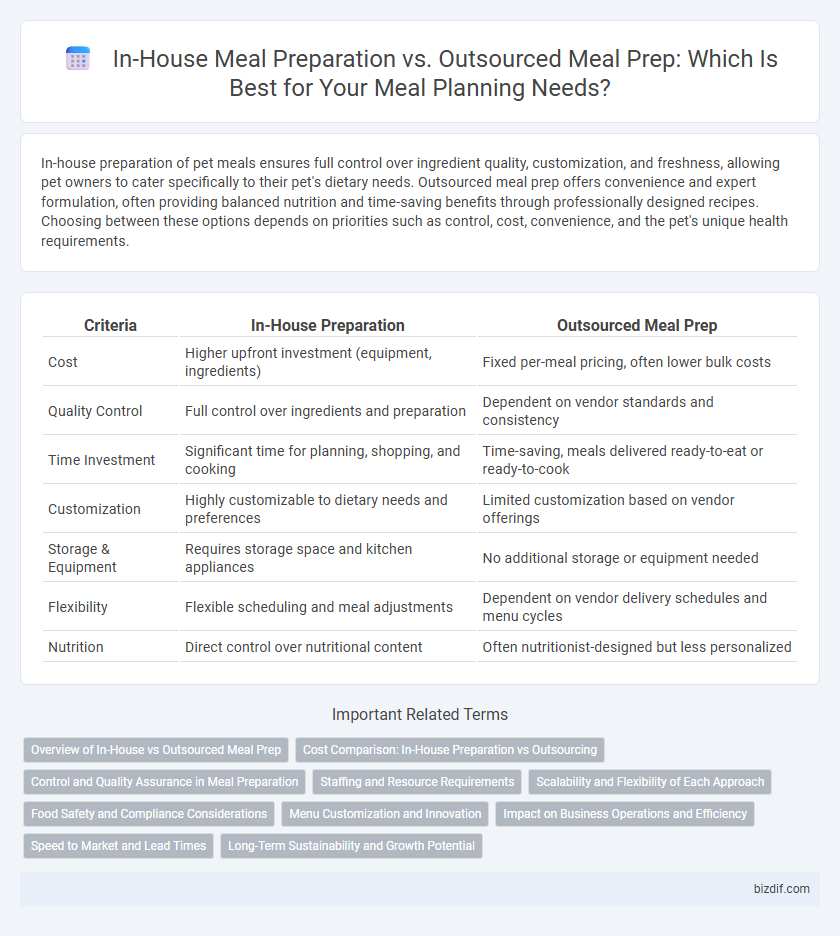In-house preparation of pet meals ensures full control over ingredient quality, customization, and freshness, allowing pet owners to cater specifically to their pet's dietary needs. Outsourced meal prep offers convenience and expert formulation, often providing balanced nutrition and time-saving benefits through professionally designed recipes. Choosing between these options depends on priorities such as control, cost, convenience, and the pet's unique health requirements.
Table of Comparison
| Criteria | In-House Preparation | Outsourced Meal Prep |
|---|---|---|
| Cost | Higher upfront investment (equipment, ingredients) | Fixed per-meal pricing, often lower bulk costs |
| Quality Control | Full control over ingredients and preparation | Dependent on vendor standards and consistency |
| Time Investment | Significant time for planning, shopping, and cooking | Time-saving, meals delivered ready-to-eat or ready-to-cook |
| Customization | Highly customizable to dietary needs and preferences | Limited customization based on vendor offerings |
| Storage & Equipment | Requires storage space and kitchen appliances | No additional storage or equipment needed |
| Flexibility | Flexible scheduling and meal adjustments | Dependent on vendor delivery schedules and menu cycles |
| Nutrition | Direct control over nutritional content | Often nutritionist-designed but less personalized |
Overview of In-House vs Outsourced Meal Prep
In-house meal prep offers full control over ingredient quality, customization, and portion sizes, allowing businesses to tailor meals to specific dietary needs and brand standards. Outsourced meal prep reduces operational overhead and eliminates the need for dedicated kitchen staff, providing scalability and access to professional culinary expertise. Evaluating factors such as cost, consistency, flexibility, and food safety determines the best approach for efficient, high-quality meal service.
Cost Comparison: In-House Preparation vs Outsourcing
In-house meal preparation often requires investment in kitchen equipment, ingredients, and labor, which can drive up fixed and variable costs. Outsourcing meal prep typically offers cost savings through bulk purchasing and streamlined operations by specialized providers, reducing overhead expenses. Businesses must analyze volume, quality control, and operational efficiency to determine the most cost-effective approach between in-house and outsourced meal preparation.
Control and Quality Assurance in Meal Preparation
In-house meal preparation offers superior control over ingredient selection, cooking methods, and hygiene standards, ensuring consistent quality and customization aligned with dietary goals. Conversely, outsourced meal prep relies on external suppliers' adherence to quality assurance protocols, which may introduce variability and reduce direct oversight. Companies prioritizing strict quality control often favor in-house preparation to maintain brand integrity and guarantee meal safety.
Staffing and Resource Requirements
In-house meal preparation demands dedicated kitchen staff, culinary expertise, and significant investment in equipment and storage facilities to ensure consistent quality and timely production. Outsourcing meal prep alleviates staffing burdens by leveraging specialized providers who manage labor, sourcing, and compliance, often offering scalable solutions with reduced overhead. Evaluating resource allocation and workforce availability is crucial to determine the most efficient approach for maintaining operational efficiency in meal prep services.
Scalability and Flexibility of Each Approach
In-house meal prepping offers greater control and customization but often limits scalability due to resource constraints and kitchen capacity. Outsourced meal prep services provide scalable solutions with the ability to handle large volumes and diverse menus, enabling businesses to quickly adjust to demand fluctuations. Flexibility in outsourcing allows for varied dietary options and menu rotations without the need for additional infrastructure or labor management.
Food Safety and Compliance Considerations
Meal prepping in-house requires strict adherence to local health codes and FDA regulations, ensuring proper sanitation, temperature control, and allergen management to minimize contamination risks. Outsourced meal prep providers often hold certifications such as ServSafe or HACCP, offering verified compliance with food safety standards and reducing liability for businesses. Evaluating suppliers' food safety protocols and traceability systems is crucial for maintaining regulatory compliance and protecting consumer health.
Menu Customization and Innovation
In-house meal preparation offers greater menu customization, allowing chefs to tailor dishes to specific dietary preferences, seasonal ingredients, and unique flavor profiles. Outsourced meal prep services often rely on standardized menus, which can limit innovation and the flexibility to experiment with new recipes or accommodate niche dietary needs. Businesses seeking highly personalized and innovative meal options typically benefit from maintaining control over their kitchen operations.
Impact on Business Operations and Efficiency
In-house meal preparation offers greater control over ingredient quality and customization, enhancing brand consistency and customer satisfaction, but demands significant labor costs and kitchen space allocation. Outsourcing meal prep streamlines operations by reducing staffing needs and overhead expenses, allowing businesses to focus on core activities while relying on specialized providers for bulk meal production. The decision impacts supply chain management, turnaround time, and scalability, with outsourced options typically improving operational efficiency but potentially compromising flexibility.
Speed to Market and Lead Times
In-house meal prepping offers faster turnaround times due to direct control over production schedules, enabling quick adjustments to market demand and reducing lead times significantly. Outsourced meal prep often involves longer lead times because of coordination between vendors and potential batching of orders, which can delay speed to market. Companies aiming for rapid product launches typically benefit from in-house operations, while those prioritizing scalability may consider outsourcing despite longer lead times.
Long-Term Sustainability and Growth Potential
In-house meal preparation allows for greater control over ingredient quality and customization, fostering brand loyalty and long-term sustainability through consistent customer satisfaction. Outsourced meal prep offers scalability and cost-efficiency, enabling rapid business growth and access to advanced food production technologies without significant capital investment. Balancing in-house and outsourced strategies can optimize operational efficiency while supporting sustainable expansion in the competitive meal prep industry.
In-house preparation vs outsourced meal prep Infographic

 bizdif.com
bizdif.com